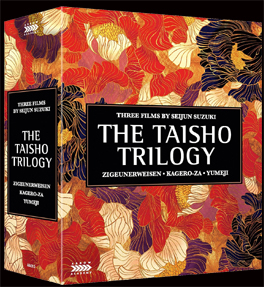 THE
TAISHO TRILOGY: ZIGEUNERWEISEN (1980)/KAGERÔ-ZA
(1981)/YUMEJI (1991) Blu-ray/DVD combo
THE
TAISHO TRILOGY: ZIGEUNERWEISEN (1980)/KAGERÔ-ZA
(1981)/YUMEJI (1991) Blu-ray/DVD comboDirector: Seijun Suzuki
Arrow Academy
 THE
TAISHO TRILOGY: ZIGEUNERWEISEN (1980)/KAGERÔ-ZA
(1981)/YUMEJI (1991) Blu-ray/DVD combo
THE
TAISHO TRILOGY: ZIGEUNERWEISEN (1980)/KAGERÔ-ZA
(1981)/YUMEJI (1991) Blu-ray/DVD comboThe once-prolific auteur Seijun Suzuki bounced back from a thirteen year slump after his Nikkatsu days with the independent art films that comprise THE TAISHO TRILOGY on Blu-ray/DVD combo from Arrow Academy.
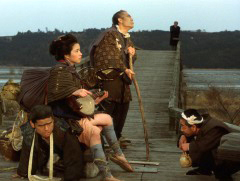
In ZIGEUNERWEISEN, the life of reserved military academy German teacher Taeko Aochi (Kisako Makishi) becomes inextricably entangled with gregarious former colleague Nakasago (Yoshio Harada, STRAY CAT ROCK: BEAT '71) through the women in their lives. First coming to Nakasago's defense when he is accused to murdering a fisherman's widow with whom he was romantically involved, Taeko finds himself the not entirely unwelcome third wheel in a triangle with geisha O-Ine (Naoko Ôtani). A married man, Taeko is discomforted by Nakasago's randy nature even as he admits that he envies him his freedom and selfishness – not to mention the a blind trio of father, daughter, and student musicians whose carryings on almost seem to be performed for Taeko's gaze. Taeko next sees Nakasago the following year upon learning that he has married, and he is shocked to discover that the bride Sono bears a striking resemblance to O-Ine, and that he treats her no more better than the geisha. After Sono gives birth to a daughter Takayo, Nakasago abandons her to wander around like a gypsy, and her craving for Taeko's visits edge towards impropriety. When Nakasago returns with the "Spanish Fly Plague", the infection kills Sono before their child is fully weened, and Taeko is shocked to discover that Nakasago has hired O-Ine as wet nurse (and she insists they are married). Taeko finds the pattern of abandonment and craving repeated with the geisha, but he has started to have doubts about his own relationship with his wife Shuko (Michiyo Ohkusu, FACE) whose dying, blind sister tells him that she has seen her sister in Nakasago's company.
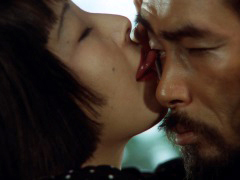 When
his termination from Nikkatsu and the drawn-out lawsuit against the company
(which he would win) consigned Suzuki to infrequent television productions and
feature films, he took advantage of a deal with producer Genjiro Arato to create
something quite unlike his genre work for Nikkatsu (or even the satirical take
BRANDED TO KILL that ended his career with the company) with the first of what
would become "The Taisho Trilogy" so named after the fourteen year
post-WWI reign of Emperor Taisho, a period whose literary and artistic culture
was characterized by the “erotic, grotesque, nonsense.” Those three
words can certainly be used to describe ZIGEUNERWEISEN in which Suzuki enlivens
up a what should be a straightforward melodrama with outrageous imagery, bizarre
peripheral characters like the blind musicians who function as sort of a Greek
chorus with earthy songs about the "natural" interaction between the
sexes, and visualizations of the erotic that are equally grotesque (including
eye-licking and the savoring of overripe fruit). While it is easy to conjecture
that Taeko and Nakasago are two sides of the same person, the depiction of the
women in the film is not as reductive as it seems and is actually quite stimulating
as both traditional (geisha) and modern (Shuko) are seen as equally enigmatic,
irrational, and even mad from the perspective of the Western-dressed by reserved
Taeko and the kimono-wearing wild man Nakasago (a clump of hair that hangs over
his left eye almost looks like a pirate's eyepatch). Takeo learning from his
unreliable (and possibly covetous) sister-in-law that his wife has visited her
with Nakasago cuts to an "attack" on Shuko by the other man who chases
her in circles around her home. As Nakasago prepares to leave Sono to follow
the blind musical trio (simply to see what becomes of them), he proposes that
the two men try swapping wives. While Nakasago appears to have acted upon this
proposition – either before or after he made it – it is left ambiguous
as to whether the dismissive Taeko has acted upon it other than Sono revealing
that she and her husband have named their daughter after him. The suggestion
of ghosts and possession weave their way through the story through Shuko's increasingly
bizarre behavior and O-Ine's belief that Takayo talks to a father she could
hardly remember in her dreams, giving O-Ine a reason to repeated visits to Taeko
to request the return of items Nakasago loaned to him – including the
titular musical recording which picked up unintelligible words spoken by the
performer, the meaning of which the two men have puzzled over throughout the
film – in hopes of seducing Taeko.
When
his termination from Nikkatsu and the drawn-out lawsuit against the company
(which he would win) consigned Suzuki to infrequent television productions and
feature films, he took advantage of a deal with producer Genjiro Arato to create
something quite unlike his genre work for Nikkatsu (or even the satirical take
BRANDED TO KILL that ended his career with the company) with the first of what
would become "The Taisho Trilogy" so named after the fourteen year
post-WWI reign of Emperor Taisho, a period whose literary and artistic culture
was characterized by the “erotic, grotesque, nonsense.” Those three
words can certainly be used to describe ZIGEUNERWEISEN in which Suzuki enlivens
up a what should be a straightforward melodrama with outrageous imagery, bizarre
peripheral characters like the blind musicians who function as sort of a Greek
chorus with earthy songs about the "natural" interaction between the
sexes, and visualizations of the erotic that are equally grotesque (including
eye-licking and the savoring of overripe fruit). While it is easy to conjecture
that Taeko and Nakasago are two sides of the same person, the depiction of the
women in the film is not as reductive as it seems and is actually quite stimulating
as both traditional (geisha) and modern (Shuko) are seen as equally enigmatic,
irrational, and even mad from the perspective of the Western-dressed by reserved
Taeko and the kimono-wearing wild man Nakasago (a clump of hair that hangs over
his left eye almost looks like a pirate's eyepatch). Takeo learning from his
unreliable (and possibly covetous) sister-in-law that his wife has visited her
with Nakasago cuts to an "attack" on Shuko by the other man who chases
her in circles around her home. As Nakasago prepares to leave Sono to follow
the blind musical trio (simply to see what becomes of them), he proposes that
the two men try swapping wives. While Nakasago appears to have acted upon this
proposition – either before or after he made it – it is left ambiguous
as to whether the dismissive Taeko has acted upon it other than Sono revealing
that she and her husband have named their daughter after him. The suggestion
of ghosts and possession weave their way through the story through Shuko's increasingly
bizarre behavior and O-Ine's belief that Takayo talks to a father she could
hardly remember in her dreams, giving O-Ine a reason to repeated visits to Taeko
to request the return of items Nakasago loaned to him – including the
titular musical recording which picked up unintelligible words spoken by the
performer, the meaning of which the two men have puzzled over throughout the
film – in hopes of seducing Taeko.
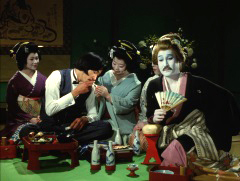
The second part of the trilogy KAGERÔ-ZA deals more overtly with the possibility of ghosts as Shungo Matsuzaki (Yûsaku Matsuda, BLACK RAIN) encounters a beautiful young woman who asks that he escort her to the hospital because of her fear of a woman (Michiyo Ohkusu again) who sells bladder cherries containing stolen souls. He buys a cherry from the woman who claims that the soul-stealing is just a harmless children's game even as she claims to have taken his. Nothing improper transpires between then but the next day he runs into another similar looking woman who is more forward, confronting him with a love letter he has written to a married woman, and they do have sex before she reveals herself to be Ine (Eriko Kusuda), the wife of one of his former colleagues Tamawaki (Katsuo Nakamura, PLEASURES OF THE FLESH) who has recently returned from teaching in Germany. Shungo mentions his meeting with Ine to Tamawaki who is oddly curious about the woman. When they learn that Tamawaki's estranged wife had been in the hospital and had passed away, Shungo is haunted by the question of the identity of the woman who claimed to be Tamawaki's wife. He learns from Tamawaki's current m mistress Mio (Mariko Kaga, PALE FLOWER) that Tamawaki had two wives, the first being a German aristocrat who was driven mad in her attempts to look and act Japanese for her husband, and a second Japanese one whose whereabouts are unknown, leading Shungo to further wonder just which of the wives has died and which was the one he encountered (or if they are one in the same). When Shungo receives a letter from the woman that reads "Next time we die as lovers," he is uncertain whether she expects them to commit suicide or if Tamawaki will murder them as he accompanies Shungo in his search for the woman specifically "to watch lovers die."
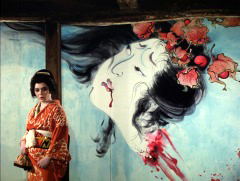 Featuring
a more compelling "storyline" than ZIGEUNERWEISEN, KAGERÔ-ZA
nevertheless meanders endlessly around what there is of a plot as if challenging
the viewer to read far more into it than is on the screen. The schism between
the traditional and the modern in the Taisho era is pronounced here more so
than ZIGEUNERWEISEN, with the various Misses Tamawaki seem almost like apparitions
from an earlier time in their kimonos, while Tamawaki's insistence on his German
wife's transformation seems almost an act of sadism. The reserved Shungo (although
we know he has been involved with a married woman) finds no humor or diversion
in a game that is "too complicated to play" as Tamawaki himself even
dresses in drag to catch Shungo's attention from a distance as "the blond
Geisha" and tells Ine (who may or may not be the German Irene) that it
is silly to die for love. The aside of the soul-bearing bladder cherries (Tamawaki
and Shungo even refer to the first woman he met as "bladder cherry"
for lack of any other way to identify her) suggests an intercourse between souls
that may indeed unite Shungo and one of the wives as lovers. The title translates
as HEAT-HAZE THEATER, and there is a certain staginess to Shungo's initial encounters
with the women, and a handful of "flashbacks" conclude with the recollecting
characters appearing in the same shot without a cut.
Featuring
a more compelling "storyline" than ZIGEUNERWEISEN, KAGERÔ-ZA
nevertheless meanders endlessly around what there is of a plot as if challenging
the viewer to read far more into it than is on the screen. The schism between
the traditional and the modern in the Taisho era is pronounced here more so
than ZIGEUNERWEISEN, with the various Misses Tamawaki seem almost like apparitions
from an earlier time in their kimonos, while Tamawaki's insistence on his German
wife's transformation seems almost an act of sadism. The reserved Shungo (although
we know he has been involved with a married woman) finds no humor or diversion
in a game that is "too complicated to play" as Tamawaki himself even
dresses in drag to catch Shungo's attention from a distance as "the blond
Geisha" and tells Ine (who may or may not be the German Irene) that it
is silly to die for love. The aside of the soul-bearing bladder cherries (Tamawaki
and Shungo even refer to the first woman he met as "bladder cherry"
for lack of any other way to identify her) suggests an intercourse between souls
that may indeed unite Shungo and one of the wives as lovers. The title translates
as HEAT-HAZE THEATER, and there is a certain staginess to Shungo's initial encounters
with the women, and a handful of "flashbacks" conclude with the recollecting
characters appearing in the same shot without a cut.
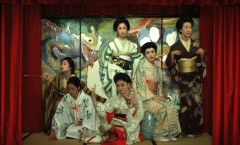
Produced a full ten years after KAGERÔ-ZA due to the producer's financial difficulties is the finale of the trilogy: YUMEJI, a fictional and fanciful look at the life of poet and painter Yumeji Takehisa (singer Kenji Sawada, THE HAPPINESS OF THE KATIKURIS). As lustful as he is creative – the style of his drawings could be likened to a less homoerotic version of the works of Victorian artist Aubrey Beardsley – Yumeji is troubled by a dream in which he is unable to see the face of a woman gliding high above him in the trees. He is then accosted by a man in a top hat whose face is concealed by a fan bearing a drawing of his own likeness, leading to a dual in which Yumeji will surely die. When his married mistress Hikono (Masumi Miyazaki, STRANGE CIRCUS) stands him up when they plan to run away and elope, Yumeji travels to a rural spa town where he learns from the hotel owner (Michiyo Ohkusu, ZATOICHI: THE BLIND SWORDSMAN'S PILGRIMAGE) that there is a manhunt for a man named Onimatsu (Kazuhiko Hasegawa, THE MAN WHO STOLE THE SUN) who is accused of murdering his wife and her lover. Taking a dip in the lake which is inexplicably stained pink, Yumeji startles Tomoyo (Tomoko Mariya, TOKYO HEAVEN), a widow who periodically takes a boat out onto the lake to search for the corpse of her husband. She invites Yumeji back to her villa but resists any of his advances that stop just short of impropriety but eventually resents and poses for a pornographic picture that leads to sex. Running into the detective (Akaji Maro, KILL BILL) who had once persecuted him on a charge of treason for which he was cleared, in the village hunting Onimatsu (known to the locals as "Demon Matsu"), Yumeji learns that the lover who stole Onimatsu's woman was Wakiya, husband of Tomoyo. Coming to believe that the top-hatted Wakiya is his dueling rival in the dream, Yumeji becomes obsessed with proving that the man is really dead by helping Tomoyo find his body or making sure that Onimatsu gets to Wakiya before he can get to him. When model Oyo (Leona Hirota, ENDLESS WALTZ) shows up with news of Hikono, she takes a job at a nearby club Evening Primrose to stay near to Yumeji who has lost interest in her after painting and then bedding her. Yumeji attends the opening of the club only to discover that it is the Hanazawa villa of the very much alive Wakiya (Yoshio Harada, 9 SOULS).
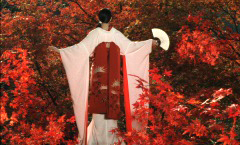 Probably
the most thematically- and stylistically-successful of the Taisho trilogy, YUMEJI
seems to share more with KAGERÔ-ZA than ZIGEUNERWEISEN on the surface
with the contrast of the traditional and the modern, from the Japanese-styled
Wakiya mansion of large empty rooms where Tomoyo sits and silently waits to
Wakiya's European-styled villa full of music and flappers, Yumeji and Wakiya
as dandies in pinstriped suits versus the kimono-garbed Matsu, to Yumeji's paintings
which eroticize women in and out of kimonos in poses that mimic Japanese portraiture
as well as older Japanese erotica. Wakiya is a trickster and manipulator similar
to KAGERÔ-ZA's Tamawaki in that his desire to kill Yumeji seems to have
less to do with the pornographic picture of his wife as proof of her infidelity
than a sadistic thrill with the surface motivation of as much importance to
the detective as a means of terrifying Yumeji, Hikono, and Oyo who herself is
motivated less by love and more by attaching herself to an artist like Yumeji's
more intellectual counterpart Inamura (Tamasaburô Bandô). Ultimately,
Yumeji seems to end with the artist coming to the realization that there is
no real counterpart to the unattainable woman of his fantasies. YUMEJI is probably
better known to the mainstream due to the memorable recycling of Shigeru Umebayashi
"Yumeji's Theme" in Wong Kar Wai's IN THE MOOD FOR LOVE.
Probably
the most thematically- and stylistically-successful of the Taisho trilogy, YUMEJI
seems to share more with KAGERÔ-ZA than ZIGEUNERWEISEN on the surface
with the contrast of the traditional and the modern, from the Japanese-styled
Wakiya mansion of large empty rooms where Tomoyo sits and silently waits to
Wakiya's European-styled villa full of music and flappers, Yumeji and Wakiya
as dandies in pinstriped suits versus the kimono-garbed Matsu, to Yumeji's paintings
which eroticize women in and out of kimonos in poses that mimic Japanese portraiture
as well as older Japanese erotica. Wakiya is a trickster and manipulator similar
to KAGERÔ-ZA's Tamawaki in that his desire to kill Yumeji seems to have
less to do with the pornographic picture of his wife as proof of her infidelity
than a sadistic thrill with the surface motivation of as much importance to
the detective as a means of terrifying Yumeji, Hikono, and Oyo who herself is
motivated less by love and more by attaching herself to an artist like Yumeji's
more intellectual counterpart Inamura (Tamasaburô Bandô). Ultimately,
Yumeji seems to end with the artist coming to the realization that there is
no real counterpart to the unattainable woman of his fantasies. YUMEJI is probably
better known to the mainstream due to the memorable recycling of Shigeru Umebayashi
"Yumeji's Theme" in Wong Kar Wai's IN THE MOOD FOR LOVE.

Previously released more than a decade ago by Kino Video in less than satisfactory transfers with dull resolution, chroma noise in fine detail, and burnt-in subtitles (the 1.66:1 YUMEJI was also non-anamorphic), the improvements in Arrow's 1080p24 MPEG-4 AVC high definition presentations of THE TAISHO TRILOGY are subtle but noticeable and quite welcome. The color palette is deliberately reserved, favoring browns of burnished wood and dark forest greens with more saturated colors making themselves known when needed (like the optically superimposed red crab between the legs of a drowned woman's corpse in ZIGEUNERWEISEN or the cyclorama backdrops of the children's theater in KAGERÔ-ZA). Most improved are the fine patterns of the twenties clothing from the men's suits to the women's chic clothing while more traditional clothing also evinces new textures. YUMEJI is the most colorful, but this appears to be as much due to it being a more recent picture as by design with more of a reliance on primary hues (particularly reds) in the costumes, set design, and in nature. The Japanese LPCM 2.0 stereo tracks are clean with some spread given to the music but otherwise largely sedate sound design. The optional English subtitles also translate song lyrics unlike previous editions as well as onscreen text.
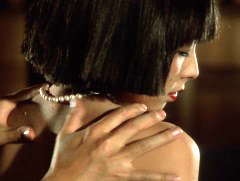 Tony
Rayns is all over these editions, providing introductions to each film as well
as an overview of the trilogy. In the introduction to ZIGEUNERWEISEN (13:32),
Rayns discusses the circumstances that lead to Suzuki tackling the film and
the proposed trilogy, how it was barred from screening by the studio-owned theaters
due to its being independently-produced and because of bad blood from Suzuki's
lawsuit against Nikkatsu, leading producer Genjiro Arato to come up with the
novel solution of outdoor screenings on top of shopping mall rooves under mobile
tents. The film would end up being the hit of the year. The first disc also
includes "Tony Rayns on the Taisho Trilogy" (10:38) in which Rayns
elaborates on the Taisho period, its cultural values, and how they weave their
way through the trilogy. The theatrical trailer (2:34) is also included. In
the introduction to KAGERÔ-ZA (17:21), Rayns discusses author Kyoka Izumi
and how the film actually draws from several of his works besides the title,
as well as his popularity among leftists despite his isolationist/nationalist
stance due to the intense and obsessive romanticism of his works (FRUITS OF
PASSION's Shûji Terayama had previously adapted one of his stories for
the best of the anthology film PRIVATE COLLECTIONS which also featured shorts
by Walerian Borowczyk and Just Jaeckin). KAGERÔ-ZA also includes an interview
with Suzuki (25:44) – who died this February – who also discusses
the origins of the trilogy, his partnership with producer Arato, and the commercial
concerns that lead to casting certain performers for the series among other
subjects, as well as the theatrical trailer (2:34).
Tony
Rayns is all over these editions, providing introductions to each film as well
as an overview of the trilogy. In the introduction to ZIGEUNERWEISEN (13:32),
Rayns discusses the circumstances that lead to Suzuki tackling the film and
the proposed trilogy, how it was barred from screening by the studio-owned theaters
due to its being independently-produced and because of bad blood from Suzuki's
lawsuit against Nikkatsu, leading producer Genjiro Arato to come up with the
novel solution of outdoor screenings on top of shopping mall rooves under mobile
tents. The film would end up being the hit of the year. The first disc also
includes "Tony Rayns on the Taisho Trilogy" (10:38) in which Rayns
elaborates on the Taisho period, its cultural values, and how they weave their
way through the trilogy. The theatrical trailer (2:34) is also included. In
the introduction to KAGERÔ-ZA (17:21), Rayns discusses author Kyoka Izumi
and how the film actually draws from several of his works besides the title,
as well as his popularity among leftists despite his isolationist/nationalist
stance due to the intense and obsessive romanticism of his works (FRUITS OF
PASSION's Shûji Terayama had previously adapted one of his stories for
the best of the anthology film PRIVATE COLLECTIONS which also featured shorts
by Walerian Borowczyk and Just Jaeckin). KAGERÔ-ZA also includes an interview
with Suzuki (25:44) – who died this February – who also discusses
the origins of the trilogy, his partnership with producer Arato, and the commercial
concerns that lead to casting certain performers for the series among other
subjects, as well as the theatrical trailer (2:34).
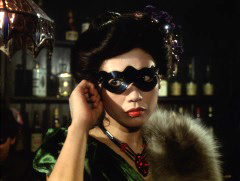 Rayns'
introduction to YUMEJI (24:19) finds him providing information on the real Yumeji
who was indeed a womanizer, and that the three women in the film are based on
real women in his life, while also taking care to point out that the film is
in no way a biography. He also discusses the cast, including Sawada who resisted
playing sexually ambiguous characters (insisting that his lover in Paul Schrader's
MISHIMA be played by an actual woman) while noting the ways in which Suzuki
seemed to have manipulated that image. In discussing the theme of the film,
he distills that of the entire series to being the impossibility of sustaining
an idealized vision of beauty. YUMEJI also includes a videotaped making-of featurette
(10:07) covering the dance choreography and the filming of the lake scenes (in
which the motor that powers the boat ostensibly gliding across the lake at fast
speed is heard) with no interviews, as well as the film's theatrical trailer
(4:37). The first pressing comes with a booklet featuring writing on the films
by critic Jasper Sharp and more, which was not supplied for review.
(Eric Cotenas)
Rayns'
introduction to YUMEJI (24:19) finds him providing information on the real Yumeji
who was indeed a womanizer, and that the three women in the film are based on
real women in his life, while also taking care to point out that the film is
in no way a biography. He also discusses the cast, including Sawada who resisted
playing sexually ambiguous characters (insisting that his lover in Paul Schrader's
MISHIMA be played by an actual woman) while noting the ways in which Suzuki
seemed to have manipulated that image. In discussing the theme of the film,
he distills that of the entire series to being the impossibility of sustaining
an idealized vision of beauty. YUMEJI also includes a videotaped making-of featurette
(10:07) covering the dance choreography and the filming of the lake scenes (in
which the motor that powers the boat ostensibly gliding across the lake at fast
speed is heard) with no interviews, as well as the film's theatrical trailer
(4:37). The first pressing comes with a booklet featuring writing on the films
by critic Jasper Sharp and more, which was not supplied for review.
(Eric Cotenas)